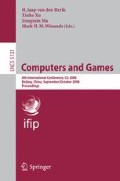Abstract
In this paper, we present two statistical experiments on the frequency distribution of patterns in the game of Go. In these experiments, we extract contextual patterns of Go as spatial combinations of moves. An analysis of a collection of 9447 professional game records of Go shows that the frequency distribution of contextual patterns in professional games displays a Mandelbrot fit to Zipf’s law. Additionally, we show that the Zipfian frequency distribution of Go patterns in professional games is deliberate by rejecting the null hypothesis that the frequency distribution of patterns in random games exhibits a Zipfian frequency distribution.
Access this chapter
Tax calculation will be finalised at checkout
Purchases are for personal use only
Preview
Unable to display preview. Download preview PDF.
References
Abramson, B.: Expected-outcome: a general model of static evaluation. IEEE Transactions on PAMI 12, 182–193 (1990)
Abramson, M., Harry, W.: A distributed reinforcement learning approach to pattern inference in Go. In: International Conference on Machine Learning Applications, Los Angeles, CA (2003)
Benson, D.B.: Life in the game of Go. Information Sciences, 10(2), 17-29, 1976; Levy D.N.L., (ed.). Reprinted in Computer Games Vol. II pp. 203-213. Springer, New York (1988)
Bouzy, B., Helmstetter, B.: Monte-Carlo Go Developments. In: van den Herik, H.J., Iida, H., Heinz, E.A. (eds.) Advances in Computer Games, Many Games, Many Challenges, pp. 159–174 (2003)
Bouzy, B., Chaslot, G.: Monte-Carlo Go reinforcement learning experiments. In: IEEE 2006 Symposium on Computational Intelligence in Games, Reno, USA (2006)
Cazenave, T.: Generation of patterns with external conditions for the game of Go. In: Advances in Computer Games Conference, Paderborn (1999)
Cho, C.: Go: A Complete Introduction to the Game. Kiseido Publishing Co (1997)
Li, W.: Random texts exhibit Zipf’s-law-like word frequency distribution. IEEE Transactions on Information Theory 38(6), 1842–1845 (1992)
Liu, Z., Dou, Q.: Automatic Pattern Acquisition from game Records in Go. Journal of China Universities of Posts and Telecommunications 14(1), 100–105 (2007)
Mandelbrot, B.B.: Simple games of strategy occurring in communication through natural languages. In Symposium on Statistical Methods in Communication Engineering (1954); Also appeared in Transactions of IRE (professional groups on information theory), 3, 124-137 (1954)
Miller, G.A., Chomsky, N.: Finitary models of language users. In: Luce, R.D., Bush, R., Galanter, E. (eds.) Handbook of Mathematical Psychology, vol. 2. Wiley, New York (1963)
Müller, M.: Computer Go. Artificial Intelligence 134(1-2), 145–179 (2002)
Müller, M.: Position Evaluation in Computer Go. ICGA Journal 25(4), 219–228 (2002)
Nakamura, T.: Acquisition of move sequence patterns from game record database using n-gram statistics. In: Game Programming Workshop 1997(1997) (in Japanese)
Schaeffer, J., van den Herik, H.J.: Games, Computers, and Artificial Intelligence. Artificial Intelligence 134(1-2), 1–7 (2002)
Sinclair, J.: Corpus and text: Basic principles. In: Wynne, M. (ed.) Guide to good practice in developing linguistic corpora (2005)
Zipf, G.K.: Human Behavior and the Principle of Least Effort. Addison-Wesley Press, Cambridge (1949)
Zobrist, A.: A model of visual organization for the game of go. In: Proceedings AFIPS 34, pp. 103–112 (1969)
Author information
Authors and Affiliations
Editor information
Rights and permissions
Copyright information
© 2008 Springer-Verlag Berlin Heidelberg
About this paper
Cite this paper
Liu, Z., Dou, Q., Lu, B. (2008). Frequency Distribution of Contextual Patterns in the Game of Go. In: van den Herik, H.J., Xu, X., Ma, Z., Winands, M.H.M. (eds) Computers and Games. CG 2008. Lecture Notes in Computer Science, vol 5131. Springer, Berlin, Heidelberg. https://doi.org/10.1007/978-3-540-87608-3_12
Download citation
DOI: https://doi.org/10.1007/978-3-540-87608-3_12
Publisher Name: Springer, Berlin, Heidelberg
Print ISBN: 978-3-540-87607-6
Online ISBN: 978-3-540-87608-3
eBook Packages: Computer ScienceComputer Science (R0)

